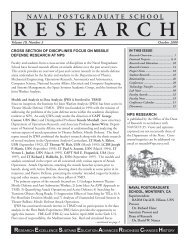Spectral Unmixing Applied to Desert Soils for the - Naval ...
Spectral Unmixing Applied to Desert Soils for the - Naval ...
Spectral Unmixing Applied to Desert Soils for the - Naval ...
Create successful ePaper yourself
Turn your PDF publications into a flip-book with our unique Google optimized e-Paper software.
and Kruse, 2011; Green et al., 1988)) portion per<strong>for</strong>ms noise suppression within <strong>the</strong> data<br />
as well as some reduction in both spatial and spectral space. Pixel Purity Index (PPI)<br />
determination is where <strong>the</strong> purest pixels (endmembers) are identified using convex<br />
geometry. Endmembers are <strong>the</strong>n visualized through utilization of <strong>the</strong> n-dimensional<br />
visualizer in <strong>the</strong> ENVI software package. The endmembers were identified through <strong>the</strong><br />
use of both <strong>the</strong> ASD spectral library described previously and libraries built by USGS<br />
(Clark et al., 2007). The endmembers were <strong>the</strong>n run through <strong>the</strong> MTMF spectral (partial)<br />
unmixing process <strong>to</strong> determine location and abundance in <strong>the</strong> HSI data.<br />
b. The MTMF Method<br />
MTMF involves three analysis steps. Step one involves an MNF<br />
trans<strong>for</strong>m, step two calculates <strong>the</strong> matched filter, and step three is where mixture tuning<br />
(MT) occurs. MT utilizes convex geometry <strong>to</strong> measure pixel mixture probabilities that<br />
are composites of both <strong>the</strong> target spectrum and background spectra. MTMF is an<br />
au<strong>to</strong>mated process that only requires <strong>the</strong> data and predetermined endmembers (Boardman<br />
and Kruse, 2011). In order <strong>for</strong> step one <strong>to</strong> occur, pre-processing of <strong>the</strong> data must be<br />
completed. Pre-processing has two main objectives per<strong>for</strong>med as part of <strong>the</strong> execution of<br />
<strong>the</strong> MNF trans<strong>for</strong>m (Boardman and Kruse, 2011). During <strong>the</strong> pre-processing phase,<br />
noise whitening is done via decorrelation of noise present in <strong>the</strong> data and unit variance<br />
across all dimensions of <strong>the</strong> spectra. The noise whitening and data characterization step<br />
is a crucial part of <strong>the</strong> MTMF process because it is a main element of what allows<br />
estimation and target detection within <strong>the</strong> imagery (Boardman and Kruse, 2011). Three<br />
possible options exist in estimating an MNF trans<strong>for</strong>m, estimation using a shift<br />
difference, using a dark current image, or through use of known noise parameters. All<br />
three methods are statistical approaches that are useful under varying conditions. The<br />
end result is <strong>to</strong> determine <strong>the</strong> eigenvec<strong>to</strong>rs and project <strong>the</strong> noise whitened data on<strong>to</strong> <strong>the</strong>m<br />
in order <strong>to</strong> decorrelate <strong>the</strong> data using equation (7) from Boardman and Kruse (2011).<br />
43
















